What is a Food Safe Disinfectant?
Stop Guessing—Here’s the Safest Way to Disinfect Food
When it comes to food safety, we don’t mess around. In our kitchens, our factories, and our homes, we’re on a mission to keep things clean—and we mean truly clean.
But what is a food safe disinfectant? That question sounds simple, yet it's packed with science, safety, and smart choices. Let’s dive in, get a little dirty with the details, and walk out squeaky clean with real answers.
What Is a Food Safe Disinfectant?
A food safe disinfectant kills harmful germs without leaving toxic residues on surfaces that touch food. That includes prep tables, knives, conveyor belts, and even our hands. These disinfectants are non-toxic at recommended levels and are often approved by the Environmental Protection Agency (EPA) or local food safety authorities.
Why It Matters
We care about food safe disinfectants because:
· Foodborne illness is real—It’s not worth the risk
· Leftover chemicals = danger—Toxic residues are a no-go
· Compliance saves money—Failing food safety inspections hurts

Common Ingredients in Food Safe Disinfectants
Hypochlorous Acid
We’ll start with our favorite. Hypochlorous acid (HOCl) is produced naturally by white blood cells. It's powerful enough to kill bacteria but gentle enough to touch. We use our Hypochlorous Acid Generator to produce this solution on-site.
Benefits include:
· Works in concentrations as low as 100 ppm
· No rinse required after use
· Safe for all food contact surfaces
Quaternary Ammonium (Quats)
Quats are synthetic compounds often used in commercial kitchens. They’re effective but leave behind residues that need rinsing. Not ideal for fast-paced environments.
Sodium Hypochlorite
Better known as chlorine bleach, this classic disinfectant is strong but tricky. Its high reactivity can damage surfaces and it must be diluted carefully.
Chlorine Solutions
Sodium hypochlorite-based solutions are common, but dilution and test strips are critical. Too strong, and it's dangerous. Too weak, and it's useless. The safe level sits around 100 ppm for food use.
Choosing the Right Disinfectant
Check the Label
Look for keywords:
· Safe sanitizer
· Sanitize food contact surfaces
· Approved by EPA
· Active ingredients like HOCl or sodium hypochlorite
Review the Data Sheet
This isn’t just paperwork. The Safety Data Sheet (SDS) explains how to use the product, what PPE you need, and the correct contact time. Always keep it on hand.
Use Test Strips
You wouldn’t cook without a thermometer, right? Same logic. Test strips ensure your disinfectant sits at a safe level—especially chlorine-based ones.
Why We Swear by HOCl
We’ve tested quats. We’ve handled bleach. But nothing beats hypochlorous acid for simplicity and peace of mind. Here’s why we use our Hypochlorous Acid Generator every day:
· No harsh chemicals
· No safety gloves needed
· No environmental guilt
· Yes to fresh smell
· Yes to NSF and EPA-compliance
It’s gentle enough to mist into the air and strong enough to knock out salmonella. That’s what we call balance.
Cleaning and Sanitizing: Know the Difference
Let’s clear this up:
Cleaning = Removing dirt and grease
Sanitizing = Killing germs
You’ve got to clean before you sanitize. Greasy build-up makes disinfectants useless. Think of it like painting over rust—it looks good but it won’t hold.
Tips to Sanitize Like a Pro
Here’s how we keep our kitchens inspection-ready:
1. Wash with detergent—Don’t skip this
2. Rinse thoroughly—Get that soap off
3. Apply sanitizer—Use correct dilution
4. Use test strips—Aim for that golden 100 ppm
5. Let it air dry—No wiping required unless label says so
Keep It Legal and Safe
The Environmental Protection Agency (EPA) maintains a list of approved disinfectants and sanitizers. Always double-check your product there. Using unregistered products can result in legal fines—and worse, food recalls.
Our Story with Food Safe Disinfectants
We started as skeptics. Can a solution be this safe and still be effective? After switching to HOCl, we saw fewer failed swabs, happier inspectors, and fewer compliance headaches. Our team breathes easier. Our customers trust us more.
Quick Checklist: Is It Really Food Safe?
✅ EPA-registered
✅ Leaves no toxic residue
✅ Effective at 100 ppm
✅ Safe on skin and surfaces
✅ Listed in the SDS
✅ Works fast (under 60 seconds)
✅ No rinse needed
Final Thoughts: You Deserve Peace of Mind
We get it—there are hundreds of cleaning products out there. But only a few meet the gold standard of food safety. Don’t take shortcuts. If it touches food, it needs to be safe enough to eat off.
That’s why we trust our Hypochlorous Acid Generator to deliver every time. Clean shouldn’t come with risk. It should come with confidence.
